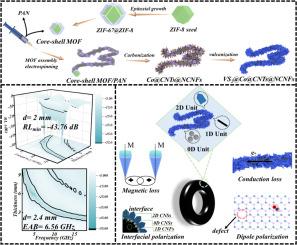Hierarchical fiber composites assembled from MOF-derived hollow polyhedral for electromagnetic wave absorption
IF 14.3
1区 材料科学
Q1 MATERIALS SCIENCE, MULTIDISCIPLINARY
引用次数: 0
Abstract
The appropriate component design and structure regulation are efficient strategies for the generation of high-efficiency electromagnetic wave absorbers, especially for problems such as the single loss mechanism and insufficient impedance matching of transition metal sulfides in electromagnetic wave absorption. Based on this, a hierarchical 0D@1D@2D fiber composite was fabricated, inspired by the "snowflake" in nature. The hierarchical fiber structure integrated with multiple heterogeneous interfaces satisfies the synergistic interaction between different components, and superior EMW absorption performance is attained. The minimum reflection loss (RLmin) of the VCCC fiber composites is −43.76 dB, and the effective absorption bandwidth (EAB) is up to 6.56 GHz. Owing to the presence of multiple non-homogeneous interfaces, the 0D@1D@2D hierarchical VS2@Co@CNTs@NCNFs (VCCC) fiber composites exhibit intense interfacial polarization, while defects in the samples emerge as polarization centers, producing dipole polarization. Synergistic effects of electrostatic spinning-derived 1D carbon nanofiber “stems”, VS2-derived 2D nanosheets “petals”, and 0D metal Co nanoparticles “stamens”. The excellent structural design endows the VCCC fiber composites with favorable conductive loss and polarization loss, while the magnetic Co nanoparticles endow the materials with intense magnetic loss, enabling the VCCC fiber composites to exhibit favorable electromagnetic wave absorption properties. Finally, this work provides a powerful reference for the development of EMW absorbing materials based on transition metal sulfides.

由mof衍生的中空多面体组装成用于电磁波吸收的分层纤维复合材料
适当的元件设计和结构调整是产生高效电磁波吸收剂的有效策略,特别是针对电磁波吸收中过渡金属硫化物的单损耗机制和阻抗匹配不足等问题。在此基础上,受自然界“雪花”的启发,制作了层次化的0D@1D@2D纤维复合材料。层次化的光纤结构集成了多个非均质界面,满足了不同组分之间的协同作用,获得了优异的EMW吸收性能。VCCC纤维复合材料的最小反射损耗(RLmin)为- 43.76 dB,有效吸收带宽(EAB)高达6.56 GHz。由于存在多个非均匀界面,0D@1D@ 2d分层VS2@Co@CNTs@NCNFs (VCCC)纤维复合材料表现出强烈的界面极化,而样品中的缺陷以极化中心的形式出现,产生偶极子极化。静电纺丝衍生1D纳米碳纤维“茎”、vs2衍生2D纳米片“花瓣”和0D金属Co纳米颗粒“雄蕊”的协同效应。优良的结构设计使VCCC纤维复合材料具有良好的导电损耗和极化损耗,而磁性Co纳米颗粒使材料具有强烈的磁损耗,使VCCC纤维复合材料具有良好的电磁波吸收性能。最后,本研究为基于过渡金属硫化物的EMW吸波材料的开发提供了有力的参考。
本文章由计算机程序翻译,如有差异,请以英文原文为准。
求助全文
约1分钟内获得全文
求助全文
来源期刊

Journal of Materials Science & Technology
工程技术-材料科学:综合
CiteScore
20.00
自引率
11.00%
发文量
995
审稿时长
13 days
期刊介绍:
Journal of Materials Science & Technology strives to promote global collaboration in the field of materials science and technology. It primarily publishes original research papers, invited review articles, letters, research notes, and summaries of scientific achievements. The journal covers a wide range of materials science and technology topics, including metallic materials, inorganic nonmetallic materials, and composite materials.
 求助内容:
求助内容: 应助结果提醒方式:
应助结果提醒方式:


